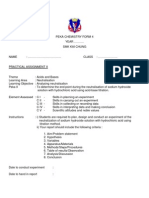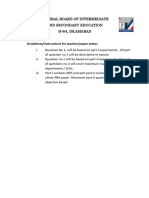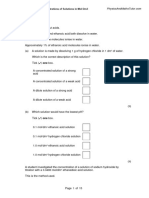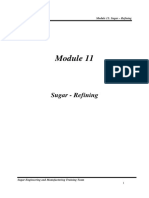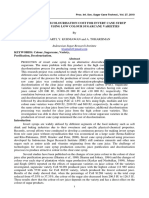PAG 2 Chemistry Questions
PAG 2 Chemistry Questions
Uploaded by
furqaanamjad328Copyright:
Available Formats
PAG 2 Chemistry Questions
PAG 2 Chemistry Questions
Uploaded by
furqaanamjad328Original Title
Copyright
Available Formats
Share this document
Did you find this document useful?
Is this content inappropriate?
Copyright:
Available Formats
PAG 2 Chemistry Questions
PAG 2 Chemistry Questions
Uploaded by
furqaanamjad328Copyright:
Available Formats
OCR A Level Chemistry A (H432) Chemistry B (H433)
PAG 2: Acid-base titration
Practice Exam Questions and Mark Scheme
This resource includes exam questions from both Chemistry A and Chemistry B. It is not designed as a
topic test but is instead intended as a document to support the teaching and learning of Module 1 –
Development of practical skills in chemistry.
1. The equation for the reaction of aqueous phosphoric(V) acid, H3PO4, with aqueous sodium
hydroxide, NaOH(aq) is shown below.
H3PO4(aq) + 3NaOH(aq) → Na3PO4(aq) + 3H2O(l)
25.0 cm3 of a 0.200 mol dm−3 H3PO4(aq) is titrated with 0.600 mol dm−3 NaOH(aq).
Which statement is correct?
A. The end point occurs when 25.00 cm3 of NaOH(aq) has been added.
B. The end point occurs when 75.00 cm3 of NaOH(aq) has been added.
C. After titration the final solution contains 0.0150 mol of Na3PO4.
D. After titration the final solution contains 0.0150 mol of H2O.
Your answer
[1]
2. A student carries out a titration. Sodium hydroxide solution is transferred to a conical flask using a
pipette. Methyl orange indicator is added to the flask. Hydrochloric acid is added from a burette
until the indicator changes colour.
Which of the following would lead to the titre being larger than it should be?
A. Rinsing the conical flask with water before adding the sodium hydroxide solution.
B. Rinsing the burette with water before filling it with hydrochloric acid.
C. Rinsing the pipette with water before filling it with sodium hydroxide solution.
D. Adding extra drops of indicator.
Your answer
[1]
3. A student prepares a standard solution and carries out a titration.
Which of the following would result in a titre that is larger than it should be?
1: Water is added to completely fill the volumetric flask, rather than to the graduation line.
2: The conical flask is washed out with water before carrying out each titration.
3: The pipette is washed out with water before carrying out each titration.
A. 1, 2 and 3
B. Only 1 and 2
C. Only 2 and 3
D. Only 1
Your answer
[1]
Created in ExamBuilder 1 © OCR 2020
OCR A Level Chemistry A (H432) Chemistry B (H433)
PAG 2: Acid-base titration
Practice Exam Questions and Mark Scheme
4. A student carries out a titration to determine the molar mass of an unknown acid, A.
• The student dissolves 2.24 g of acid A in distilled water and makes the solution up to 250.0 cm3.
• The student titrates a 25.0 cm3 portion of this solution with 0.120 mol dm−3 NaOH.
• 25.25 cm3 of 0.120 mol dm−3 NaOH are required to reach the end point.
Name the apparatus that the student should use to
• make up the acid solution to 250.0 cm3
• measure the 25.0 cm3 portion of acid solution.
make up the acid solution to 250 cm3:
measure the 25.0 cm3 portion:
[1]
5. A student carries out a titration to determine the molar mass and structure of a weak acid A.
The student follows the method below.
Dissolve a weighed mass of A in 100 cm3 of distilled water and make the solution up to 250 cm3
•
in a beaker.
• Add the solution of A to a burette.
• Titrate the solution of A with a standard solution of sodium hydroxide, NaOH.
What is meant by the term standard solution?
[1]
Created in ExamBuilder 2 © OCR 2020
OCR A Level Chemistry A (H432) Chemistry B (H433)
PAG 2: Acid-base titration
Practice Exam Questions and Mark Scheme
6. A student carries out an experiment to identify an unknown carbonate.
• The student weighs a sample of the solid carbonate in a weighing bottle.
• The student tips the carbonate into a beaker and weighs the empty weighing bottle.
• The student prepares a 250.0 cm3 solution of the carbonate.
• The student carries out a titration using 25.0 cm3 of this solution measured using a pipette with
0.100 mol dm−3 hydrochloric acid in the burette.
The sample of carbonate is dissolved in approximately 100 cm3 of distilled water in a beaker and the
solution transferred to a volumetric flask. The volume of the solution is made up to 250.0 cm3 with
distilled water.
Another student suggests two possible sources of error:
• A small amount of solid remained in the weighing bottle.
• A small amount of solution remained in the beaker.
State whether the other student’s statements are correct.
How could the procedure be improved?
[2]
Created in ExamBuilder 3 © OCR 2020
OCR A Level Chemistry A (H432) Chemistry B (H433)
PAG 2: Acid-base titration
Practice Exam Questions and Mark Scheme
7(a). A student carries out a titration to determine the molar mass and structure of a weak acid A.
The student follows the method below.
Dissolve a weighed mass of A in 100 cm3 of distilled water and make the solution up to 250 cm3
•
in a beaker.
• Add the solution of A to a burette.
• Titrate the solution of A with a standard solution of sodium hydroxide, NaOH.
The student carries out a trial, followed by three further titrations.
The diagram shows the initial and final burette readings for the three further titrations.
The student measures all burette readings to the nearest 0.05 cm3.
Titration 1 Titration 2 Titration 3
Initial reading Final reading Initial reading Final reading Initial reading Final reading
i. Record the student’s readings and the titres in the table below.
Calculate the mean titre, to the nearest 0.05 cm3, that the student should use for analysing the results.
Titration 1 Titration 2 Titration 3
Final reading/cm 3
Initial reading/cm3
Titre/cm3
cm3 [4]
mean titre =
ii. The uncertainty in each burette reading is ± 0.05 cm3.
Calculate the percentage uncertainty for the titre in Titration 1.
percentage uncertainty = % [1]
Created in ExamBuilder 4 © OCR 2020
OCR A Level Chemistry A (H432) Chemistry B (H433)
PAG 2: Acid-base titration
Practice Exam Questions and Mark Scheme
iii. The student realised that the solution of A had not been prepared correctly.
How should the student have made up the solution?
[1]
(b). A student repeats the titration to determine the molar mass and structure of A.
• The student prepares a 250.0 cm3 solution from 1.513 g of A.
The solution of A is added to the burette and titrated with 25.0 cm3 volumes of 0.112 mol dm−3
•
NaOH(aq).
• 1 mol of A reacts with 2 mol of NaOH.
• The student obtains a mean titre of 27.30 cm3.
i. Calculate the molar mass of A from these results.
Give your answer to the nearest whole number.
Show your working.
molar mass of A = g mol−1 [4]
ii. A is an organic acid, containing C, H and O only.
One molecule of A contains two COOH groups.
Suggest the structure of A.
[1]
Created in ExamBuilder 5 © OCR 2020
OCR A Level Chemistry A (H432) Chemistry B (H433)
PAG 2: Acid-base titration
Practice Exam Questions and Mark Scheme
8(a). A student carries out a titration to determine the concentration of some hydrochloric acid.
The student titrates the hydrochloric acid against a standard solution of sodium carbonate, Na2CO3.
The equation is shown below.
Na2CO3(aq) + 2HCl (aq) → 2NaCl (aq) + H2O(l) + CO2(g)
• The student prepares 0.150 mol dm−3 Na2CO3 in a 250.0 cm3 volumetric flask.
• The hydrochloric acid is added to a 50.0 cm3 burette.
• The student pipettes the Na2CO3(aq) using a 25.0 cm3 pipette.
The student’s burette readings are shown in the table.
The rough titre has been omitted.
i. Complete the table by adding the titres to the table.
Final reading / cm3 24.60 48.45 34.30
Initial reading / cm3 0.40 24.60 10.00
Titre / cm3
................... ................... ...................
[1]
ii. Calculate the mean titre of HCl , to the nearest 0.05 cm3, that the student should use for
analysing the results.
mean titre = .................................................. cm3 [1]
(b). Calculate the concentration, in mol dm−3, of the hydrochloric acid.
Give your answer to 3 significant figures.
concentration of HCl = .......................................... mol dm−3 [3]
Created in ExamBuilder 6 © OCR 2020
OCR A Level Chemistry A (H432) Chemistry B (H433)
PAG 2: Acid-base titration
Practice Exam Questions and Mark Scheme
(c). In the titrations, the student measured volumes with a pipette and a burette.
• The pipette had an uncertainty of ± 0.04 cm3 in the volume measured.
• The burette had an uncertainty of ± 0.05 cm3 in the volume measured.
Determine whether the volume measured by the pipette or the volume measured by the burette has the
greater percentage uncertainty.
[2]
9. Some students are given a drain cleaner that is described as ‘50% NaOH solution’. They are told
that this means that roughly 50 g NaOH are dissolved in 100 cm3 solution.
The students have a standard 0.300 mol dm−3 solution of HCl and they wish to use this to find the
accurate concentration of the drain cleaner.
The students accurately dilute a certain volume of the drain cleaner to 1000 cm3.
i. Calculate the volume of drain cleaner the students need to dilute to get a suitable solution
for titration with the acid.
volume = .......................................... cm3 [3]
ii. Suggest the apparatus used by the students to dilute the drain cleaner.
[1]
Created in ExamBuilder 7 © OCR 2020
OCR A Level Chemistry A (H432) Chemistry B (H433)
PAG 2: Acid-base titration
Practice Exam Questions and Mark Scheme
10. Concrete contains calcium hydroxide, Ca(OH)2, and is alkaline when damp. The steel reinforcements in
concrete do not corrode in an alkaline environment. When the calcium hydroxide reacts with carbon
dioxide from the air to form calcium carbonate, ‘carbonatation’ occurs and the pH falls. The increased
acidity can cause the steel to corrode.
The indicator phenolphthalein can be used to detect carbonatation in concrete.
Phenolphthalein has a variety of related structures, depending on the pH.
i. Give the colours of phenolphthalein for normal concrete and for concrete that has undergone
carbonatation.
normal:
carbonatation:
[1]
ii. An acid is titrated with a strong alkali using phenolphthalein until the pink colour just persists.
If the solution is then allowed to stand in the titration flask it slowly goes colourless.
Explain what is happening.
[2]
Created in ExamBuilder 8 © OCR 2020
OCR A Level Chemistry A (H432) Chemistry B (H433)
PAG 2: Acid-base titration
Practice Exam Questions and Mark Scheme
11. Describe the techniques and procedures used to prepare a standard solution of a specific
concentration from a solid.
[6]
Created in ExamBuilder 9 © OCR 2020
You might also like
- Me YeetusDocument4 pagesMe YeetusalaNo ratings yet
- Experiment 2 Standardization of Sodium Hydroxide With HCLDocument2 pagesExperiment 2 Standardization of Sodium Hydroxide With HCLvafaashkNo ratings yet
- CHM256 - Laboratory ManualDocument27 pagesCHM256 - Laboratory ManualSyahshaiNo ratings yet
- 04-Clarification, Phosphatation, Jul. 07, 2017Document39 pages04-Clarification, Phosphatation, Jul. 07, 2017jantskie100% (3)
- 2001 - Davis - The Chemistry of Colour RemovalDocument9 pages2001 - Davis - The Chemistry of Colour RemovalguigaldianoNo ratings yet
- PAG 2 Chemistry QuestionsDocument18 pagesPAG 2 Chemistry Questionssbailes743No ratings yet
- 2.1.4 Acids QPDocument13 pages2.1.4 Acids QPGbenga AjibikeNo ratings yet
- C4 - Review Questions Acids - and - Redox - TitrationDocument20 pagesC4 - Review Questions Acids - and - Redox - Titrationdosibo2378No ratings yet
- Semester 2 Exam 2019Document20 pagesSemester 2 Exam 2019privatepotatomanNo ratings yet
- 2019 NEAP Unit 2 ExamDocument23 pages2019 NEAP Unit 2 Examacdes3No ratings yet
- 2017 Unit 2 Chemistry KTT 6 Volumetric Analysis - Question BookDocument12 pages2017 Unit 2 Chemistry KTT 6 Volumetric Analysis - Question Bookfrank sinatraaNo ratings yet
- Directed Study 32c - Acids Bases and Buffers 3Document22 pagesDirected Study 32c - Acids Bases and Buffers 3roxygharperNo ratings yet
- Week_8_inorganicDocument15 pagesWeek_8_inorganicflappy.winger-1mNo ratings yet
- Chemistry: Written Examination 1Document25 pagesChemistry: Written Examination 1luctonNo ratings yet
- Sampletask Scicom - Chem e 200110Document17 pagesSampletask Scicom - Chem e 200110Oditor MwaangaNo ratings yet
- A Level Chemistry Unit 5 Question Paper Jan22Document32 pagesA Level Chemistry Unit 5 Question Paper Jan22dissaoctafianellisNo ratings yet
- Yr12 ATAR Chemistry Acid Base TitrationsDocument40 pagesYr12 ATAR Chemistry Acid Base TitrationsRose Amity Johnson100% (1)
- 2022 North Sydney Girls Trial Paper Criteria Sample Answers 64460ede5da5fDocument58 pages2022 North Sydney Girls Trial Paper Criteria Sample Answers 64460ede5da5fLuke FormanNo ratings yet
- Experiment - 3 - Analysis of Soda AshDocument4 pagesExperiment - 3 - Analysis of Soda AshJonathan MusongNo ratings yet
- Peka - Chemistry Form 4 - Student's and Teacher's Manual - 02 - Acid Base TitrationDocument4 pagesPeka - Chemistry Form 4 - Student's and Teacher's Manual - 02 - Acid Base TitrationWong Wai Lun88% (17)
- Abbyshay Hayle Cape Chemistry Lab Full 2021Document22 pagesAbbyshay Hayle Cape Chemistry Lab Full 2021Abby Shay Gayle100% (1)
- Campion College 6B Chemistry ' LaboratoryDocument4 pagesCampion College 6B Chemistry ' LaboratoryDaniel JenningsNo ratings yet
- STOICHIOMETRY DETERMINATION of H2O2Document6 pagesSTOICHIOMETRY DETERMINATION of H2O2ArmonistasNo ratings yet
- Lab 1 Determination of Solution ConcentrationDocument6 pagesLab 1 Determination of Solution ConcentrationMuhamad FarisNo ratings yet
- Chemistry: Written ExaminationDocument52 pagesChemistry: Written ExaminationluctonNo ratings yet
- CHAPTER 7 (C) :: Concentration of Acids and AlkalisDocument26 pagesCHAPTER 7 (C) :: Concentration of Acids and AlkalisajakazNo ratings yet
- Practice Paper 3Document38 pagesPractice Paper 3flappy.winger-1mNo ratings yet
- Final PBA Chemistry HSSC-IDocument8 pagesFinal PBA Chemistry HSSC-Ishiza javedNo ratings yet
- Target 7 Edexcel Single Science Chem WB Unit 7Document8 pagesTarget 7 Edexcel Single Science Chem WB Unit 7Noor Ulain NabeelaNo ratings yet
- Earl's Practical Test Part 2 (Lab Report Template) - Dk014Document5 pagesEarl's Practical Test Part 2 (Lab Report Template) - Dk014MALIUS BIN SUNGGI MoeNo ratings yet
- Final PBA Chemistry HSSC-I-1Document8 pagesFinal PBA Chemistry HSSC-I-121617No ratings yet
- Group 1 - 2022Document5 pagesGroup 1 - 2022macnkaforNo ratings yet
- CHM 1100-2024-fall-Experiment 9-Titration-pre-lab worksheet(1)Document2 pagesCHM 1100-2024-fall-Experiment 9-Titration-pre-lab worksheet(1)dyb599dv48No ratings yet
- As Level Chemistry A - AcidsDocument59 pagesAs Level Chemistry A - Acidssabrinaidris17No ratings yet
- Experiment V01 Standardization of Naoh and HCL Solution: ChemicalsDocument4 pagesExperiment V01 Standardization of Naoh and HCL Solution: Chemicalsgomgom112No ratings yet
- Final exam second semester - 2024Document7 pagesFinal exam second semester - 2024Jhonnyer Julian Valencia ArredondoNo ratings yet
- Final PBA Chemistry HSSC-I-1Document18 pagesFinal PBA Chemistry HSSC-I-1nab1abdul2basit3No ratings yet
- H432-01-Periodic Table, Elements and Physical Chemistry/a Level Chemistry A H432 - H432-01 - QS13Document5 pagesH432-01-Periodic Table, Elements and Physical Chemistry/a Level Chemistry A H432 - H432-01 - QS13Altay ShawNo ratings yet
- Chemistry: Written Examination 1Document21 pagesChemistry: Written Examination 1ninja980117No ratings yet
- Final PBA Chemistry HSSC-IDocument8 pagesFinal PBA Chemistry HSSC-Ijavaria4477No ratings yet
- Assessment Unit A2 3: ChemistryDocument28 pagesAssessment Unit A2 3: ChemistrypranavNo ratings yet
- Final PBA Chemistry HSSC-I-1Document8 pagesFinal PBA Chemistry HSSC-I-1marketplacef428No ratings yet
- 2020 Wassce Chemistry PracticalsDocument2 pages2020 Wassce Chemistry Practicalskojotaalaenock2007No ratings yet
- 2020 Wassce Chemistry Practicals SolutionDocument5 pages2020 Wassce Chemistry Practicals Solutionkojotaalaenock2007No ratings yet
- 9701 Nos Ps 2Document6 pages9701 Nos Ps 2Hubbak Khan0% (1)
- Campion College 6B Chemistry ' LaboratoryDocument3 pagesCampion College 6B Chemistry ' LaboratoryNickolai AntoineNo ratings yet
- Ch4 test copyDocument7 pagesCh4 test copyBahaa KaleemNo ratings yet
- PEM 2024 Chemistry Trial HSC Examination PaperDocument37 pagesPEM 2024 Chemistry Trial HSC Examination PaperSherine MetiraNo ratings yet
- Chm256-Exp 4-Labreport NewDocument7 pagesChm256-Exp 4-Labreport Newcikk ngah nanaNo ratings yet
- 12 1 Experimental Design MCQ SolvedDocument12 pages12 1 Experimental Design MCQ SolvedJoseph JoNo ratings yet
- .Pending 1731898104 PowerPoint MergeDocument56 pages.Pending 1731898104 PowerPoint Mergeshivam26683No ratings yet
- Barker 2019 Trial PaperDocument63 pagesBarker 2019 Trial PaperYuanfeng WeiNo ratings yet
- Tutorial Letter 004/6/2024: Aquatic Chemistry For Civil EngineersDocument5 pagesTutorial Letter 004/6/2024: Aquatic Chemistry For Civil EngineersFhatuwaniNo ratings yet
- CCC CC CCC CC CCC CCCDocument8 pagesCCC CC CCC CC CCC CCCfaznil100% (3)
- Acid Base Titrations LabDocument3 pagesAcid Base Titrations LabLoveena Steadman100% (1)
- SS 2 Chemsitry Practical QuestionDocument3 pagesSS 2 Chemsitry Practical QuestionozomatajoshuaNo ratings yet
- Mock Che3BDocument4 pagesMock Che3BErick MwalukasaNo ratings yet
- 3.4 Using Concentrations of Solutions in Mol Dm3 QPDocument15 pages3.4 Using Concentrations of Solutions in Mol Dm3 QPalizanarsidani2008No ratings yet
- 12-1-experimental-techniques-GWWkRpD3C8JZyNvmDocument38 pages12-1-experimental-techniques-GWWkRpD3C8JZyNvmvoltrus.gamerNo ratings yet
- Chemistry: Year 12 Assessment Block Semester 1Document23 pagesChemistry: Year 12 Assessment Block Semester 1nichollsl24No ratings yet
- College Organic Chemistry Semester II: Practice Questions with Detailed ExplanationsFrom EverandCollege Organic Chemistry Semester II: Practice Questions with Detailed ExplanationsNo ratings yet
- Lab Report - SugarDocument7 pagesLab Report - SugarPeter AndrewNo ratings yet
- Operations ManagementDocument18 pagesOperations ManagementWashi Abdullah50% (2)
- Clarification Phosphatation PDFDocument39 pagesClarification Phosphatation PDFRAJKUMARNo ratings yet
- 03-Carbonatation, Updated July 08Document32 pages03-Carbonatation, Updated July 08jantskie100% (2)
- 1946 - Rault - Working With The Carbon at at IonDocument8 pages1946 - Rault - Working With The Carbon at at IonEverton CarpaneziNo ratings yet
- Carbonation ProcessDocument4 pagesCarbonation ProcessFindi DiansariNo ratings yet
- Module 11: Sugar - RefiningDocument35 pagesModule 11: Sugar - RefiningsenaNo ratings yet
- Optimising The Carbonatation ProcessDocument8 pagesOptimising The Carbonatation ProcessSaurav BhattacharjeeNo ratings yet
- What Is A Sugar Refinery?: 4th Slide The Refining ProcessDocument2 pagesWhat Is A Sugar Refinery?: 4th Slide The Refining Processbabe0% (1)
- 1971 Bennet, The Talofloc Decolorization ProcessDocument14 pages1971 Bennet, The Talofloc Decolorization ProcessnghiNo ratings yet
- FP 22 TriantartiDocument9 pagesFP 22 TriantartiAbraham.CastilloNo ratings yet
- YuvrajDocument28 pagesYuvrajpradipNo ratings yet
- PAG 2 Chemistry QuestionsDocument9 pagesPAG 2 Chemistry Questionsfurqaanamjad328No ratings yet
- TableDocument24 pagesTableZVSNo ratings yet
- Starch and ICUMSA Color Removal in Sugarcane JuiceDocument8 pagesStarch and ICUMSA Color Removal in Sugarcane JuiceMolly0630No ratings yet
- Sugar RefiningDocument94 pagesSugar Refiningsena100% (1)
- Cane Sugar - Ion Exchange ResinDocument52 pagesCane Sugar - Ion Exchange Resinmichael john sanicoNo ratings yet



















